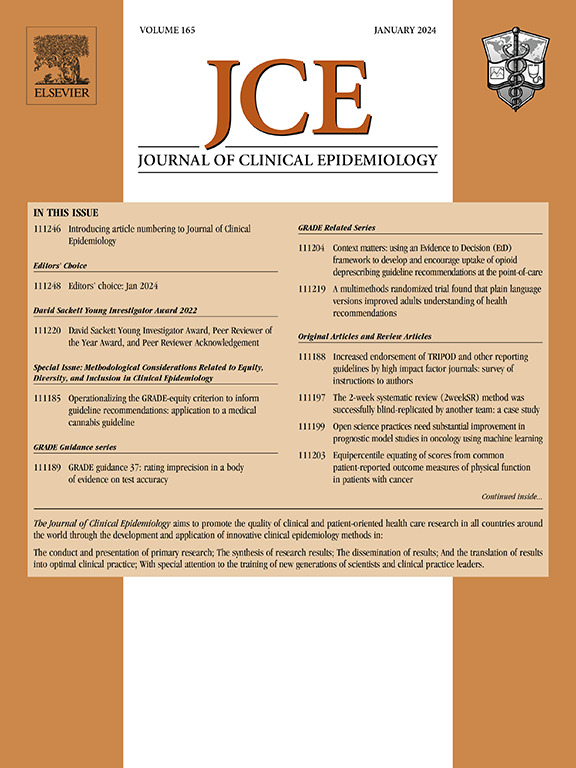牛津膝关节评分和活动与参与问卷的项目反应理论验证:向通用指标迈出的一步。
IF 7.3
2区 医学
Q1 HEALTH CARE SCIENCES & SERVICES
引用次数: 0
摘要
目的:牛津膝关节评分(OKS)和牛津膝关节活动与参与问卷(OKS-APQ)是用于评估膝关节置换手术患者的患者报告结果测量方法。这两份问卷还没有进行过明确的单维度测试(即是否测量 "膝关节健康 "等一个基本特质)。本研究采用项目反应理论(IRT)来提高测量工具的有效性,以优化其持续使用:研究设计与环境:接受初级全膝关节置换术(TKR)的参与者提供术前和术后对 OKS 和 OKS-APQ 的回答。分别对 OKS 和 OKS-APQ 进行了确认性因子分析 (CFA),然后将两者合二为一。结果:分析了 2972 个独立的反应模式。CFA表明,将OKS和OKS-APQ合二为一时,它们测量的是一种潜在的健康特质。我们开发了一个用户友好、免费使用的网络应用程序,允许临床医生上传原始数据并即时获得IRT评分:结论:OKS 和 OKS-APQ 可以合并为一个工具有效使用(产生一个分数)。对于单独的 OKS 和 OKS-APQ,可以继续向患者提供原始项目和回答选项,本研究证实了 IRT 加权评分的适用性。将 IRT 应用于现有的回答,可将传统的总分转换为更精细的连续测量,包括个体测量误差。本文章由计算机程序翻译,如有差异,请以英文原文为准。
Item response theory validation of the Oxford knee score and Activity and Participation Questionnaire: a step toward a common metric
Objectives
The Oxford knee score (OKS) and OKS Activity and Participation Questionnaire (OKS-APQ) are patient-reported outcome measures used to assess people undergoing knee replacement surgery. They have not explicitly been tested for unidimensionality (whether they measure one underlying trait such as ‘knee health’). This study applied item response theory (IRT) to improve the validity of the instruments to optimize for ongoing use.
Study Design and Setting
Participants undergoing primary total knee replacement (TKR) provided preoperative and postoperative responses for OKS and OKS-APQ. Confirmatory factor analysis (CFA) were performed on the OKS and OKS-APQ separately and then on both when pooled into one. An IRT model was fitted to the data.
Results
2972 individual response patterns were analyzed. CFA demonstrated that when combining OKS and OKS-APQ as one instrument, they measure one latent health trait. A user-friendly, free-to-use, web app has been developed to allow clinicians to upload raw data and instantly receive IRT scores.
Conclusions
The OKS and OKS-APQ can be combined to use effectively as a single instrument (producing a single score). For the separate OKS and OKS-APQ the original items and response options can continue to be posed to patients, and this study has confirmed the suitability of IRT-weighted scoring. Applying IRT to existing responses converts traditional sum scores into continuous measurements with greater granularity, including individual measurement error.
求助全文
通过发布文献求助,成功后即可免费获取论文全文。
去求助
来源期刊

Journal of Clinical Epidemiology
医学-公共卫生、环境卫生与职业卫生
CiteScore
12.00
自引率
6.90%
发文量
320
审稿时长
44 days
期刊介绍:
The Journal of Clinical Epidemiology strives to enhance the quality of clinical and patient-oriented healthcare research by advancing and applying innovative methods in conducting, presenting, synthesizing, disseminating, and translating research results into optimal clinical practice. Special emphasis is placed on training new generations of scientists and clinical practice leaders.
 求助内容:
求助内容: 应助结果提醒方式:
应助结果提醒方式:


